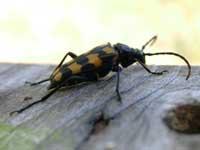Insects affected by optical illusions

Imagine, for example, that in the desert a person goes to the sun. One day go there, far away, to a group of palm trees that are being reflected in the water, an oasis! Run. Just like it sounds more running, you will arrive at the oasis and you can drink everything you want... Despite walking, it has never reached the oasis. The oasis he has seen was a mirror; the optical phenomenon that occurs when reflecting sunlight on hot surfaces. The very distant objects, in this case the palms, have seen them as if they were reflected in a lake.
We've heard this kind of stuff in stories and movies eleven times. Who or who could have the opportunity to live something like this up close if you have ever gone into a far desert.
Other living beings, such as insects living in our environment, do not go so far and, however, suffer this type of mirrors and damages. According to a group of researchers at Michigan State University, the dark and bright surfaces generated by humans, such as city buildings and asphalt roads, cause these effects on insects.

As if they were water wells
The Sun does not follow a pattern to emit the rays of light, which come out of the Sun in all directions. However, when they traverse the Earth's atmosphere and are reflected in the reflective surfaces of the Earth, light rays are ordered and taken in one direction. This light is called polarized light.
In nature, the reflective surfaces are usually water wells, used as a reference by insects and other animals. They approach the emitting zones of this special light, understanding by such water wells. Water wells are essential for some animals: they look for food in water wells and lay eggs.
Well, when the essential medium is not emitted by a building or an asphalt surface, the polarized light of reference for them, these animals suffer enormous damage. Researcher Michigan and his co-workers have found several times insects that approach the aquatic media to reproduce on the asphalt and put them on the roof of a red car.

Logically, the reflection of light as water wells does not make these places suitable to pull the eggs ahead. Therefore, the effort of many animals to maintain their species is lost.
Researchers call polarized light pollution. The biggest problem is that, according to the researchers, the buildings created by human beings are more and more numerous and, of course, more and more surface. Therefore, insects have more possibilities of making mistakes and acting in a place where they do not need it.
Several experts consider this problem to be more serious than expected. The truth is that not many studies have been done to know how far the problem comes, but they believe it reaches beyond insects. For example, turtles eat plastic bags because they reflect polarized light, apparently because they mix with their favorite food, jellyfish.
Published in Deia
Buletina
Bidali zure helbide elektronikoa eta jaso asteroko buletina zure sarrera-ontzian











